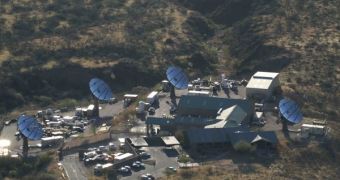A new telescope array called VERITAS (Very Energetic Radiation Imaging Telescope Array System) is a major new ground-based gamma-ray observatory, designed to provide an in-depth examination of the universe, at a much higher level of precision than was previously available.
The name also means "truth" in Latin; it is also hoped to discover the truth about the composition and the origins of the elusive dark matter.
A joint project of several institutions and funded by the U.S Department of Energy, the National Science Foundation, the Smithsonian Institution, the Natural Sciences and Engineering Research Council in Canada, Science Foundation Ireland and the Particle Physics and Astronomy Research Council in the United Kingdom, VERITAS is an array of four large optical reflectors that detects high-energy gamma rays by observing the light from secondary showers of particles that these gamma rays generate in the atmosphere.
Each telescope is made of 350 curved, six-sided mirrors, 28 inches across at the widest point, while the telescopes themselves are all about 40 feet across. Each mirror reflects the light it catches into a camera on an extension arm in front of each telescope and all the images are combined electronically.
"It is expected that this instrument will allow for the detection of an increased number of gamma ray sources, possibly even the indirect detection of the mysterious dark matter in the universe," said Karen Byrum, Argonne physicist.
The temporary location is the Whipple Observatory's administration office and visitor center on the Mount Hopkins Highway, where they will be operated for two years in an engineering mode while a permanent site is acquired and the cost was of around $20 million.
During this period, a number of key science projects will be undertaken, as well as collaborative observations with the NASA's next generation gamma-ray space telescope, scheduled for launch later this year and named GLAST (Gamma-ray Large Area Space Telescope).
Much like GLAST, VERITAS is designed to explore the high-energy Universe. It will study astrophysical and cosmological phenomena such as active galactic nuclei, pulsars, other high-energy sources and dark matter.
"Through involvement in the VERITAS collaboration, we are examining other ways to look at high energy physics and bringing to the forefront other topics connected to it,"explained Hendrik (Harry) J. M. Weerts, director of Argonne's High Energy Physics Division. "The universe, with gamma ray bursts, supernovae, and active galactic nuclei, possess nature's most powerful accelerators."

 14 DAY TRIAL //
14 DAY TRIAL //